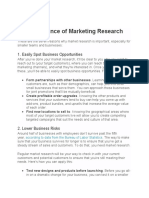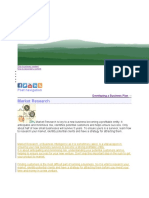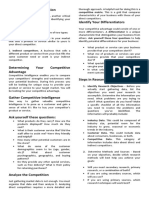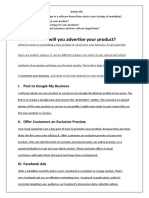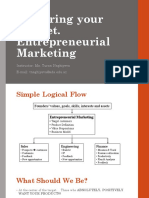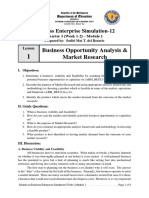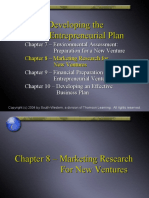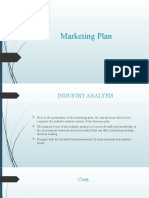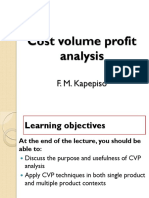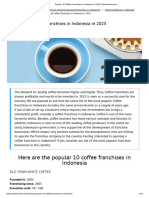BRM Assignment 2
Maria Jose
MBA PM
500073990
1. A company manufacturing brand new personal computers would like to identify
potential market segments for their brand. Suggest suitable research design to identify
market potential with justification. What would be your sampling frame in this situation?
2. ’Business research is concerned more with proper fact-finding, analysis, and evaluation. ‘Do you
agree with this statement? Give reason in support of your answer.
Answer 2: Yes, research is about finding facts, analyzing them and then evaluating the
results.
Research begins with a theory or thesis statement. This statement has to be proven or
disproven as true/false. Given that research is based on proving or disproving a theory, it
means that research is concerned with finding facts, analyzing facts and evaluating the
response, in order to form a conclusion regarding the research topic.
There have been occasions, when research has been called into question.
Corporate espionage and other issues such as; corporations skewing the facts to fit their data
have existed. It is a downside to dishonesty in people; however, the ethical, moral, and
scientific belief is that all research has to be based on facts.
This does not mean the facts will not change. Research is conducted with what information
and tools are available at that time. This means that in 100 years research being conducted
now could be found false, but at the time it is true because of the limited technology or facts
that could be found.
As always when someone learns about research and the research method, one is told that a
theory is never solely factual, but proved or disproved based on what could be found at that
time. It goes back to the fact, that proper information, analysis, and evaluation are needed in
order to conduct proper research. Inaccurate facts will skew the data and render the entire
research invalid.
�There is also the human interpretation of the information found. While research is concerned
with these three topics, one also has to realize the writer of the research can limit the scope
of the research and therefore change the results based on their viewpoint alone.
Answer 1: The Research Design used will be descriptive Markert Research athe the folloeing
are the steps to identify the potential markert to sell the goods.
1. Gather intel.
Clearly defining your target audience whether it’s senior citizens, busy moms or even as
specific as millennial’s in Texas can help you answer questions and overcome obstacles as
you kick-start your online store.
Here are a few business questions you’ll want to address:
Is the potential market for your product or service large enough?
Do you need to alter your business idea to best appeal to this audience?
Should you tailor your product or service in some way to maximize effectiveness?
How can you target your marketing efforts to optimize reach with the most promising
potential buyers?
2. Create customer profiles and market segments.
Consumers who find your product or service appealing often share similar characteristics,
which will help you fine-tune your messaging throughout the customer journey.
You can craft a customer profile to uncover those shared traits. This includes psychographic
data about how the target customer behaves and additional basic information to help you
identify your audience.
Start with demographic criteria:
Age
Location
Gender
Income level
� Education level
Marital or family status
Occupation
Ethnic background
Then add psychographic criteria to go a little deeper and paint a more complete picture of
your audience:
Interests
Hobbies
Values
Attitudes
Behaviors
Lifestyle preferences
Every industry, business and product is different, so these lists are by no means the end-all-
be-all — think of them as more of a starting point to evaluate market segment size and
opportunity.
Don’t be afraid to make adjustments and include criteria that will add interesting layers to
your profiles — the better you know your customer, the better you can sell to them.
3. Be specific.
Creating a very specific customer segment is more of an art than a science.
As you get started, try to be as specific as possible. For some brands I’ve had the opportunity
to work with, we even created profiles for our target audience, for example:
Our target audience is Mark, a 24-year-old man with a full-time job who spends his
free time going to live music shows with friends. He makes an average of $65,000 a
year and spends more money on experiences vs. material goods. He is most active on
Instagram and frequently engages with influencer-related content.
�By starting with a detailed customer profile, you’ll be able to make educated decisions when
it comes to building custom audiences and crafting compelling advertising and marketing
campaigns.
New entrepreneurs often worry that they’ll be too specific as they conduct their research,
fearing that it will limit their reach.
In reality, identifying a specific target audience helps ensure that you make decisions that are
dictated by your customers, which sets you up for long-term success.
Drill down on who your audience truly is and study:
Their attitudes,
Beliefs, and
Pain points.
Understanding their age and income is the first step, but drilling down to the core customer
problem is what will help set your products — and brand — apart from the competition.
4. Tap existing resources.
If you do a quick search online, you’ll often find existing resources that can help you pull
together information about your industry, the market segment, your competition and your
ideal potential customer.
The best part is, someone has already done the work.
In most instances, the information you gather won’t cost you a thing.
However, the downside is that the research you find may not be as focused or useful as you’d
like.
5. Look at your competition.
What’s their market positioning? What are customers actually purchasing from them?
How about their pricing? What are their customers willing to pay? Would they pay
more if you offered something extra?
� What are customers saying on social media? What social media channels are they
interacting with the most? What other interests do they list on their personal social
media pages? What do they do for a living? What are their hobbies? How are they
describing their business and products?
Are reviews screaming with opportunity? What weaknesses did you identify from
their reviews that you may be able to address with your business?
Depending on how well your competitor is doing, you may not want to go after a similar
market segment. But, on the other hand, if their customers are extremely unsatisfied with
current offerings, it may be a great opportunity to shake things up and compete head on.
Someone with a strong business acumen will identify competitors’ weaknesses, discover
overlooked areas of the market, and capitalize on new opportunities to drive online success –
with the help of concentrated marketing efforts.
6. Conduct your own primary research.
You can learn a lot about your target audience through primary research, which involves
gathering data directly from consumers.
Although primary research can be a little more expensive than other methods, it allows you to
truly listen to the voice of your customer and get answers to specific questions regarding your
business.
Here are some things you can try out:
Distribute surveys: Send surveys to existing and potential customers via mail, email
or a web-based service.
Conduct interviews: Talk to consumers who might fit in your target market. For
example, you could stand in a high-traffic area at a trade show and ask attendees to
answer a few short questions.
Assemble focus groups: Get feedback from a small group of consumers who fit your
ideal customer profile via Q&A sessions and group discussions.

